This article provides information for our Payroll Partners about the COVID-19 virus situation and what myPay Solutions is doing to assist with all of your payroll needs.
COVID – 19 American Rescue Plan Act
What is the American Rescue Plan Act?
The federal government recently passed a bill that allows for up to two weeks of paid leave for employees specifically in relation to COVID-19. This will be provided as a separate benefit from any other voluntary or state mandated leave amounts the employee is eligible for. Employers are not allowed to require employees to first use other paid leave provided by the employer before using paid sick leave under the Act.
You may be required to provide state mandated sick leave in addition to the sick leave mandated by the American Rescue Plan Act. These mandates vary by state. Please review the applicable state laws to ensure your business is compliant.
The COVID sick pay items associated to the Emergency Paid Sick Leave Act cannot be used in tandem with the COVID sick pay items associated to the American Rescue Plan.
Who is eligible for the American Rescue Plan Act?
Effective April 1, 2021 through September 30, 2021 private employers with fewer than 500 employees and all government employers may voluntarily provide up to two weeks of paid sick leave/12 weeks of paid family leave to their employees (including part-time employees).
- Is subject to a Federal, State, or local quarantine or isolation order related to COVID–19
- Has been advised by a health care provider to self-quarantine due to concerns related to COVID–19
- Is caring for an individual who is subject to such an order or has been so advised
- Is experiencing symptoms of COVID–19 and seeking a medical diagnosis
- Is caring for a son or daughter of such employee if the school or place of care of the son or daughter has been closed, if the school of such son or daughter requires or makes optional a virtual learning instruction model or requires or makes optional a hybrid of in-person and virtual learning instruction models, or the child care provider of such son or daughter is unavailable, due to COVID–19 precautions
- Is experiencing any other substantially similar condition
- Is caring for a family member with a mental or physical disability or who is 55 years of age or older and incapable of self-care, without regard to whether another individual other than the employee is available to care for such family member, if the place of care for such family member is closed or the direct care provider is unavailable due to COVID–19; or
- Is obtaining immunization related to COVID–19 or is recovering from any injury, disability, illness, or condition related to such immunization.
What is considered compensation for the American Rescue Plan Act?
The rate of pay that an employee is entitled to under this act is dependent on the reason the leave is needed. If the sick is taken under reasons 1-4 above, the required compensation must be the greater of the following:
- The employee's regular rate of pay
- The federal minimum wage rate
- The state or local minimum wage rate applicable to the employee
If the sick is taken under reason 5-8 above (Who is eligible for the ARPA), the required compensation is 2/3, or roughly 66%, of the required amount as outlined above.
Are there limits under the American Rescue Plan Act?
- $511.00 per day/$5,110.00 total if used under reasons 1-4 above (Who is eligible for the ARPA).
- $200.00 per day/$2,000.00 total if used for reason 5-8 above (Who is eligible for the ARPA).
- $200.00 per day/$12,000 total for extended care.
Is there a tax credit for the American Rescue Plan Act?
- Employers will be provided with a refundable tax credit. The credit will be the combination of the item’s wages, and the value of ERFICA-SS and ERFICA-MED for those wages.
- We are waiting for additional guidance from the government with the details of how the credit will be reported. Please click here to view the bill then scroll down to the applicable section titled Sec. 4001. EMERGENCY FEDERAL EMPLOYEE LEAVE FUND.
myPay Solutions responsibility for the American Rescue Plan Act
myPay Solutions can provide factual details surrounding the American Rescue Plan Act, but it is the client’s responsibility to determine whether or not an employee is eligible and for what reason. They must also enter or report the hours to be paid under the Act and setup or provide the applicable rates of pay. Please do not advise clients on how to handle these details. Instead direct clients to online resources or their accountant for further advise. This is also a great time to recommend Mammoth HR services to Clients. myPay Solutions clients get a significant discount due to our partnership.
What do clients who want to pay the American Rescue Plan Act Sick Leave need to do?
- Contact your Payroll Specialist and request a new wage item to track and pay the Emergency Paid Sick hours/wages. The additional wage item will be titled COVID-19 ARPA (Enter special type name). A separate wage item is required for tracking purposes as employers will be able to claim a tax credit on the amounts paid in association with the Emergency Paid Sick Leave bill. We are waiting on additional details from the government relating to the business tax credits and will make the necessary updates as needed.
The associated payroll item will be setup as regular/fully taxable wage item, and must be setup with consistent formatting for all clients: The Description and Report Description will be ARPA – (all caps with a dash) *Box 14 COVID items codes to come later.
- ARPA - Self Care
- ARPA - Other Care
- ARPA - Extended Care
- Once the COVID-19 pay item has been setup by your Payroll Specialist, you will need to activate the item for the applicable employee(s) and load in the appropriate rates.
- If you'd like to track and keep a running total of the available COVID-19 hours, please contact your Payroll Specialist for additional details.
American Rescue Plan Act Sick Leave FAQ
No. The American Rescue Plan Act Sick Leave hours must be paid to employees who qualify as a separate benefit. An employer may not require an employee to use other paid leave (vacation or sick) provided by the employer to the employee before the employee uses the available hours under this Emergency Paid Sick Leave Act.
How do I enter Emergency Paid Sick Leave for a salaried employee?
If necessary, prorate the amount to be paid as regular salary and the amount to be paid as COVID-19 wages. Enter the applicable amounts under each line item separately in Time Entry. Please reach out to your Payroll Specialist with questions.
We are waiting for additional guidance from the government with the details of how the credit will be reported.
No, these items cannot be used in tandem.
100% COBRA premium Subsidy from April 1, 2021 through September 30, 2021
Under the American Rescue Plan Act, President Biden has initiated the 100% COBRA premium Subsidy from April 1, 2021 through September 30, 2021. The credit will be provided on the FORM 941 and will be applied against the employers share of Medicare Tax.
Who is eligible?
Starting April 1st, any employees who are involuntarily terminated or have reduced schedules disqualifying the employee for health coverage and those individuals are currently enrolled in COBRA coverage.
A special enrollment period exists for two separate groups which is open on April 1st and closes after 60 days when notice of the special enrollment period is delivered to the impacted individuals.
Group #1:
- Employees who did originally elect COBRA coverage, but their COBRA period are still active are eligible the subsidy for the remaining months.
- For Example: An employee was terminated on February 1, 2020 and became eligible for COBRA coverage on March 1, 2020.
- Resulting in the 18-month COBRA coverage period would expire on August 31, 2021.
- The employee would be eligible for the COBRA premium subsidy from April 1 through August 31, 2021.
- Note, the credit does not extend the 18-month coverage period.
- For Example: An employee was terminated on February 1, 2020 and became eligible for COBRA coverage on March 1, 2020.
Group #2:
- Employees who elected COBRA coverage and allowed coverage to lapse however, their coverage period has not yet expired.
- These individuals may have allowed their coverage to lapse because they could no longer afford the COBRA premium payments.
Eligibility dates:
Begin April 1, 2021 and lasts through:
- The first month an employee is qualified for Medicare or coverage by another health plan.
- The 18-month COBRA Coverage period ends.
- September 30, 2021.
Signed tax waiver to include:
- Enter Date
- Client Name
- Client ID
- Date of request
- Quarter ending the credit is to be applied to
- Their calculated credit amounts
- Signed, title, and dated
Place signed Tax Waiver in FileCabinet under Client Tax Information.
- Place in the current year folder
- Title Document: COBRA Subsidy Qtr XX 20XX
Email MPS Supervisors, Dawn McGraw, and Tracy Schroeder notifying the waiver is in File Cabinet.
- Subject Line: COBRA Subsidy Qtr XX 20XX
- Email Details: Please reference the COBRA Subsidy tax waiver for credit associated to Qtr XX 20XX
- Log details in FLASH
Coronavirus Aid, Relief, and Economic Security Act (CARES Act)
How do I run a payroll report to help me complete my Paycheck Protection Program Loan application?
- myPay Solutions has made a Paycheck Protection Program Report available within the myPay Solutions Direct application to help determine your average monthly payroll costs.
- We have updated the Paycheck Protection Program Report to include an option to calculate 3.5x average monthly payroll costs in response to the updated stimulus package that was passed on December 27, 2020.
When choosing the parameters of the report, there is now the option to select Use 3.5x Multiplier. Show me.

- To run the Paycheck Protection Program Report, log into your secure portal, select Applications and open the myPay Solutions Direct application.
- Once the program opens, choose Print Reports from the menu on the left, and select the report titled Paycheck Protection Program.
- You can select the appropriate date range and reporting options based on your needs. The report defaults to 2019 totals and total gross wages for the timeframe selected. Show me.
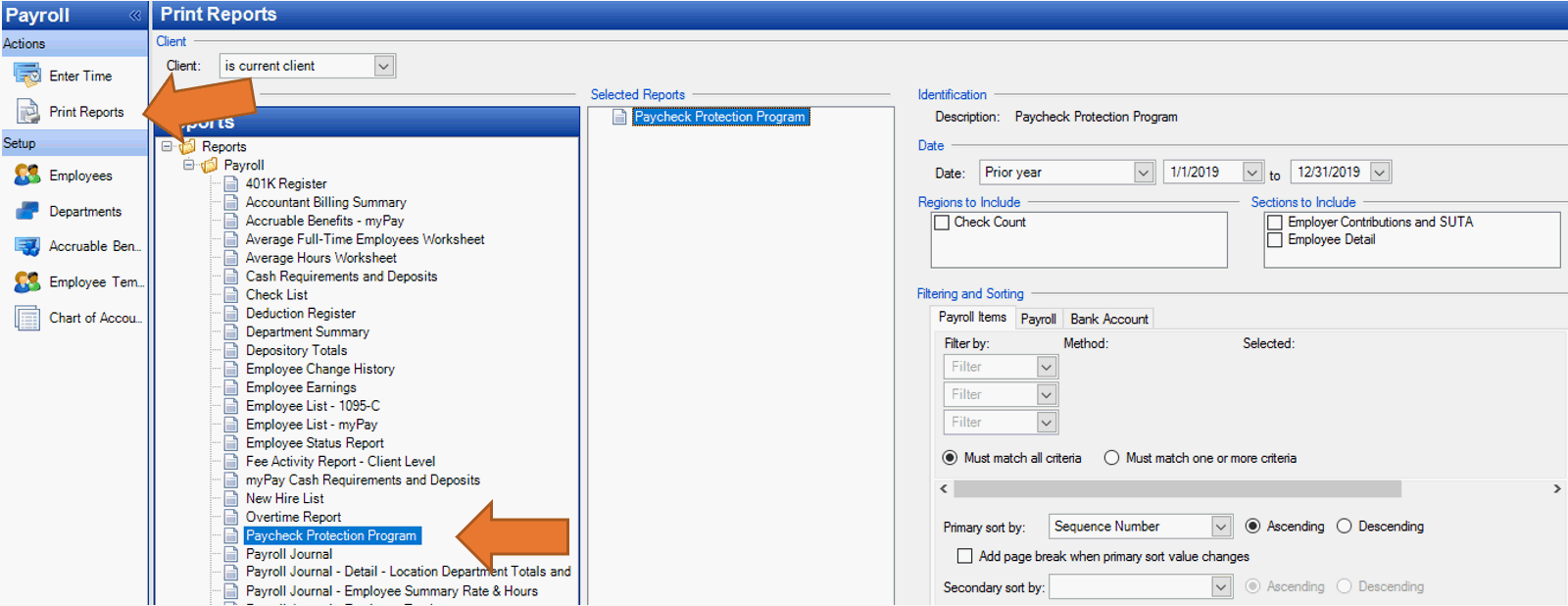
- The Paycheck Protection Program Report includes:
- Paycheck Protection Program Report example. Show me.
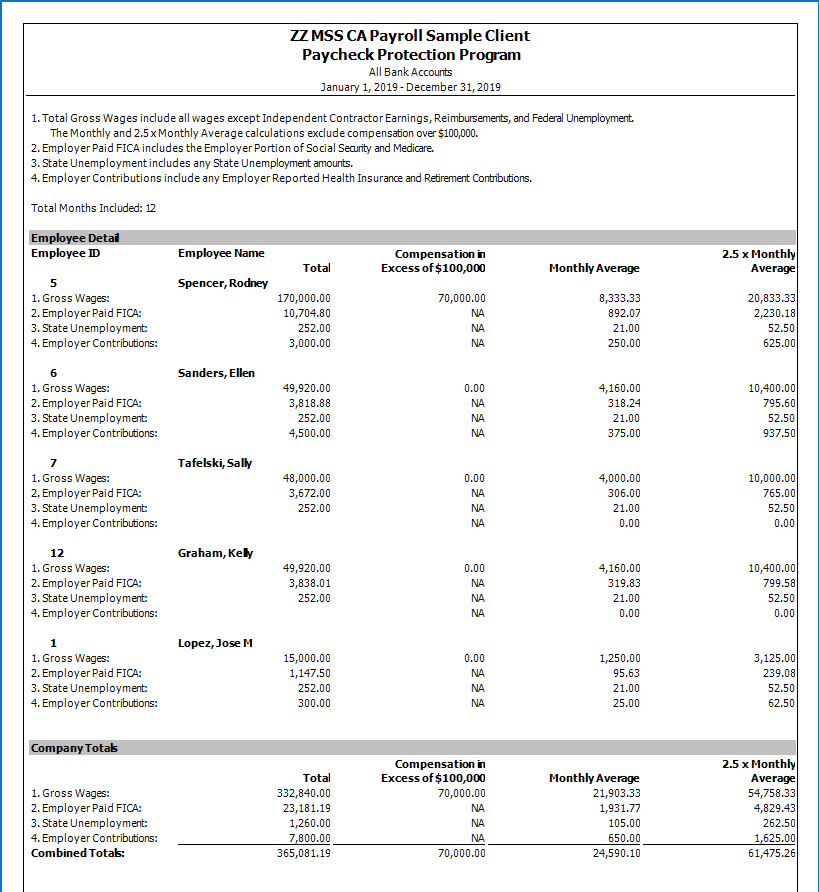
- The ability to provide details by employee or as a company.
- The following explanations listed at the top of the report:
- Total Gross Wages include all wages except Independent Contractor Earnings, Reimbursements, and Federal Unemployment. The Monthly and 2.5 x Monthly Average and 3.5 x Monthly Average calculations exclude compensation over $100,00.00.
- Employer Paid FICA includes the Employer Portion of Social Security and Medicare.
- State Unemployment includes any State Unemployment amounts.
- Employer Contributions include any Employer Reported Health Insurance and Retirement Contributions.
- Column Details for both Employee Details and Company Totals:
- Total: This is the total amount as depicted for the specified row.
- Compensation in Excess of $100,000: This is the earnings in excess of $100,000.
- Monthly Average: This is the amount listed in the total column subtracting any Compensation in Excess of $100,000 divided by 12.
- 2.5 X Monthly Average: This is the amount of the monthly average multiplied by 2.5.
- 3.5 X Monthly Average: This is the amount of the monthly average multiplied by 3.5.
- Paycheck Protection Program Report example. Show me.
- The Paycheck Protection Program Report excludes:
- 1099 wages paid
- Reimbursements (Exclusion is done by name containing “REIM”)
- Federal Unemployment Taxes
- Costs over $100,000 on an annualized basis for each employee. The amount that is in Excess of $100,000 will appear in a separate column.
- For purposes of calculating the average monthly payroll, most businesses will use the average monthly payroll costs for 2019, excluding costs over $100,000 on an annualized basis for each employee.
Note: You should confirm with your lender which specific look-back dates they require for your application. If you wish to run the report for any specific 12-month period, you can modify the date ranges of the Paycheck Protection Program Report to fit your lender’s needs.
Process:
- Specialist receives either the Form 7200, amount for Employee Retention Credit or amount for ER Sponsored health care.
- Specialist receives the signed tax waiver (See Attached). Waiver and details from step one are saved in FC under 2020 Client Tax Information.
- Email template is sent to MPS Supervisors/ Tracy/Dawn.
- MPS Supervisors will save the email in a separate folder to track if needed for future.
- Dawn will make the manual adjustments.
- Specialist submits amendment request via EMS.
- If it’s before July 15, fee for 941 amendment can be waived since they haven’t actually been transmitted yet.
- If it’s after July 15, the specialist will bill the normal 941 amendment fee since they are starting to be transmitted.
What is the Employee Retention Credit?
- The Employee Retention Credit is part of the CARES Act designed to encourage businesses to keep employees on their payroll.
- You can use the COVID-19 sick pay items under the Family First Coronavirus Response Act in conjunction with the credit, however, COVID-19 sick pay items are excluded when calculating qualifying wages.
- The offset of taxes is for employee and employer paid Social Security and Medicare taxes in addition to Federal Withholding.
- Get the full details on the IRS website regarding the Employee Retention Credit under the CARES Act.
- You should consult your accountant for further guidance if you have any questions about the Employee Retention Credit
2020
- The Employee Retention Credit provides for a fully refundable tax credit equal to 50% of qualified wages (including qualified health plan expenses) paid between 03/13/2020 and 12/31/2020. The maximum amount of qualified wages taken into account for each employee is $10,000.00 (for the year) which makes the maximum tax credit $5,000.00 ($10,000.00 x 50%) per employee (for the year).
- The calculation is a per employee calculation of gross wages up to 50% of $10,000, meaning a cap of $5,000 gross wages per eligible employee.
- This amount can include employer paid health Insurance.
2021
- The Employee Retention Credit provides for a fully refundable tax credit equal to 70% of qualified wages (including qualified health plan expenses) paid between 01/01/2021 and 12/31/2021. The maximum amount of qualified wages taken into account for each employee is $10,000.00 (for the quarter) which makes the maximum tax credit $7,000.00 ($10,000.00 x 70%) per employee (for each quarter), $14,000 per employee (for the year).
- This amount can include employer paid health Insurance.
Date editted: 01-11-21
How to Handle the Employee Retention Credit (ERC)
If a client wants to take advantage of the ERC it will require a waiver.
- Download a copy of the Tax Waiver – Employee Retention Credit and complete all of the sections in red before saving and sending the copy to your client to complete the section in blue.
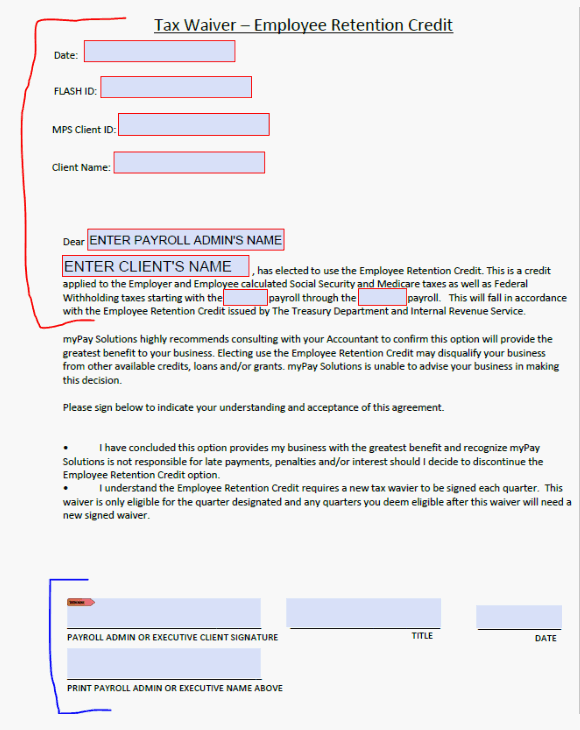
- Attach the edited copy of the waiver you filled out for your client and send it to them along with the Email Communication to Client Template. You can copy/paste from the Word document to email.
- When the client securely returns the form to you, print a copy to FileCabinet CS in the Client Tax Information folder and then use the Email Communication to TAX/MPS SUPERVISORS Template to send your request to Dawn McGraw, Tracy Schroeder, and MPS Supervisors.
Date editted: 01-11-21
myPay Solutions has added a 7200 Worksheet to assist you with completing the form.
- A new report to assist clients in completing the Small Business Administration (SBA) loan forgiveness application is now available within the myPay Solutions Direct application.
- To run the Paycheck Protection Program Loan Forgiveness Worksheet, log into your secure portal, select Applications and open the myPay Solutions Direct application.
- Once the program opens, choose Print Reports from the menu on the left, and select the report titled Paycheck Protection Program Loan Forgiveness Worksheet. Show me.
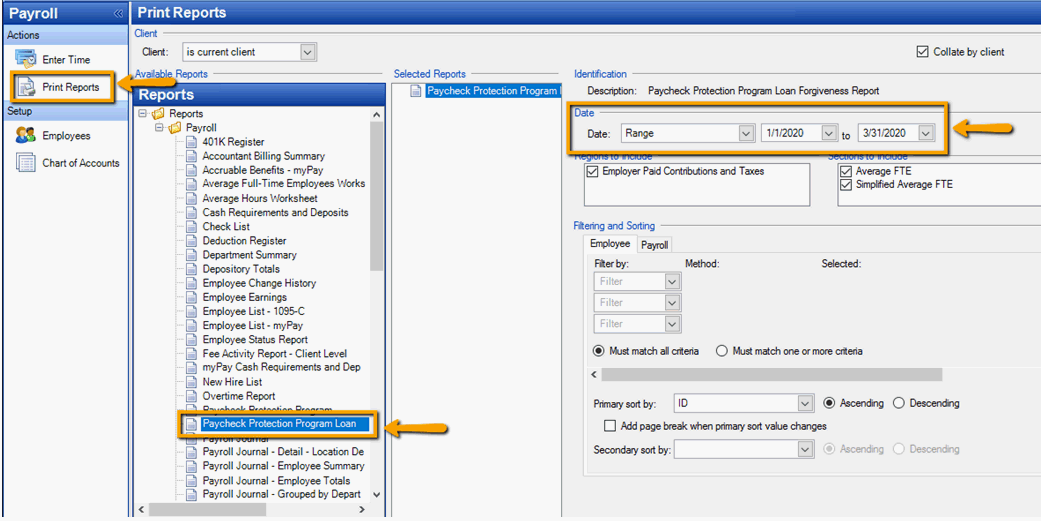
- Select the appropriate date range based on your needs.
- To get the information required on the application, you will need to run this report multiple times using various date ranges, all of which are specified in the SBA application instructions.
- For detailed information about Report contents and calculations what the contains click here to Show me.
Section headings
The Paycheck Protection Program Loan Forgiveness Worksheet includes sections that correlate to those on the loan forgiveness application. If a section doesn't apply to your business, it won't display on the report.
- Employee compensation of less than or equal to $XX,XXX.XX for the XX week time period. Use the information in this section to fill out Table 1 of the loan forgiveness application. This table requires you to enter information for employees who were paid an annualized rate of less than, or equal to the cap of $100,000.00 for all pay periods in 2019.
- Employee compensation capped at $XX,XXX.XX for the XX week period. Use the information in this section to fill out Table 2 of the loan forgiveness application. This table requires you to enter information for employees who were paid an annualized rate of more than the cap of $100,000.00 for all pay periods in 2019.
- Employer paid contributions and state/local taxes. This optional section lists the employer contributions and employer paid state and local taxes for the reporting period. If you include this information when you run the report for the PPP loan coverage period or the alternate loan coverage period, it could help complete the Non-Cash Compensation Payroll Costs During the Covered Period or the Alternative Payroll Covered Period section of the SBA loan forgiveness application.
Columns
- Cash Compensation. This column displays the employees' gross pay, excluding leave covered by the Families First Coronavirus Response Act (COVID-19 self care, other care, and extended child care).
- Average Full-time employee (FTE) calculations. For each employee, the average number of hours paid per week in the report date range is divided by 40. This is capped at 1.0 where average hours is over 40.
- Simplified Average Full-time employee (FTE) calculations. This is the calculation used in the instructions for the SBA loan forgiveness application.
- 1.0 - The employee's average number of hours paid per week in the report date range is 40 or greater
- 0.5 - The employee's average number of hours paid per week in that date range is greater than 0 but less than 40
Standard hours vs Actual hours
The Paycheck Protection Program Loan Forgiveness Worksheet assumes that an employee worked standard hours if all of the following conditions are true.
- The employee used a pay item with a Salaried amount calculation type.
- The Salaried amount pay item has an amount associated with it on the payroll check.
- The Salaried amount pay item has 0 regular hours recorded on the payroll check.
If one or more of those conditions are not true, the Paycheck Protection Program Loan Forgiveness Worksheet uses the actual hours as recorded on the payroll check.
- For more details about the Paycheck Protection Program, as specified in the CARES Act, see the PPP Borrower Information Fact Sheet (from home.treasury.gov).
I obtained a Paycheck Protection Program Loan; what comes next?
- President Trump Signs Paycheck Protection Program Flexibility Act: On 6/5/20, President Trump signed the Paycheck Protection Program Flexibility Act (PPPFA) of 2020 (H.R. 7010), which modifies provisions related to the forgiveness of loans made to small businesses under the PPP. The PPPFA (1) eliminates a CARES Act provision that prevented certain PPP participants from deferring the payment of payroll taxes; (2) requires borrowers to use at least 60% (rather than the original 75%) of PPP funds on payroll costs; (3) gives borrowers 24 weeks (rather than the original eight weeks) to spend PPP funds; (4) pushes back the original 6/30/20 deadline to rehire workers to 12/31/20; (5) provides additional exceptions if a borrower is unable to rehire the required number of employees; and (6) extends the minimum maturity date of the loan (for proceeds that are not forgiven) to five years. The full legislative text of the bill is available at www.congress.gov/bill/116th-congress/house-bill/7010/text
- Use the Treasury’s website to obtain the latest guidance or to apply for forgiveness of your PPP Loan if you qualify: U.S. Dept of Treasury PPP Website
- myPay Solutions has a report available that can help you complete your PPP Loan Forgiveness Application within the myPay Solutions Direct application. It can be found under Reports > Paycheck Protection Program Loan Forgiveness Worksheet.
- If you need to update your bank information due to an account linked to a PPP loan you received, please reference these steps on how to change your information with myPay Solutions: Changing or Updating Your Company Bank Account
- If you have questions about your application or qualification for loan forgiveness, you should consult with your accountant or loan provider.
The Coronavirus Aid, Relief, and Economic Security Act (CARES Act), enacted on March 27, 2020, is designed to encourage Eligible Employers to keep employees on their payroll, despite experiencing economic hardship related to COVID-19, with an employee retention tax credit under the Employee Retention Credit and access to a federal loan for payroll purposes under the Paycheck Protection Program.
Employee Retention Credit Eligibility Tool from Thomson Reuters
- Updated with the most recent information as of 1/20/21.
- Thomson Reuters Employee Retention Credit Eligibility Tool may be used to determine if a business qualifies for the Employee Retention Credit.
- Click here to learn more and obtain customized information: Employee Retention Credit Tool.
What is the Paycheck Protection Program?
- The Paycheck Protection Program is part of the CARES Act that allows small business to potentially receive 100% federally guaranteed loans for payroll purposes.
- Employers could be eligible for a loan of up to 2.5x to 3.5x of their average monthly payroll costs.
- To get more details about a Paycheck Protection Program Loan and to see if your business qualifies, read the U.S. Chamber's Guide to Emergency Coronavirus Loans.
- The SBA website contains a copy of the Application for a Paycheck Protection Program Loan.
- You should consult your accountant or lender for further guidance if you have any questions about obtaining a Paycheck Protection Program Loan.
My company obtained a Paycheck Protection Program Loan - what reports are available to help determine my upcoming payroll costs?
We do not have forecasting reports available within myPay Solutions Direct; however, we do have alternative reports available that can help you determine the average number of full-time employees or your payroll costs for a specified period.
- You can run the myPay Cash Requirements and Deposits Report within myPay Solutions Direct to see what your actual payroll costs were for a specified period and use those historical numbers to determine what your future payroll costs might look like.
- In order to determine the number of full-time employees for a specific time period (defined as 30 or more hours per week per ACA guidelines) you can run the Average Fulltime Employee Worksheet Report within myPay Solutions Direct.
- Both reports can be found within your myPay Solutions Direct application. Once you have launched the application, click on Print Reports from the menu on the left and choose a report from the list. Show me.

Internal: If neither of these reports work for your client or RA, there is another option that you can walk them through to get updated numbers based on their current payroll situation.
- You can explain how to create an On Demand payroll batch using myPay Solutions Direct. This will allow the client to enter different scenarios and use the preview payroll option to view the cash required. We are not providing this as a first option due to the risk of the client unintentionally submitting a payroll. Be sure to caution the client about this and recommend they always cancel the batch.
- This option also has some limitations if they are using multiple payroll items and may require additional instruction if they want to run different scenarios based on hours worked.
- Link to On Demand payroll: https://cs.thomsonreuters.com/ua/acct_pr/mypay_client/cs_us_en/topics/z_create_on_demand_payroll_dlg.htm
- In order to change the bank account information for any account that funds your payroll, please contact your Payroll Specialist directly. They will send you the bank account change form to complete and request that you provide either a copy of a voided check, a bank statement, or an online screen shot specifying the routing number, account number, account type and name on the account.
- Upload your completed bank account change form and accompanying bank documentation to File Exchange for your specialist to take action. We cannot accept banking information via e-mail or over the phone.
- Internal: Click below to download a full email template that you can send to your client if they are requesting to update their funding bank account. You will need to copy the Word document and paste it into your myPay Solutions email. Remember to personalize that attached bank account change form for the client first before sending them the email template and form: Bank Account Change Outlook Email Template.
- Internal: Click here for a blank copy of the bank change form that you can personalize by first adding their client ID and name as it is in EMS/SBPR, and indicating whether the client or accountant pays fees and then send to your client to complete the rest and return via File Exchange: Bank Change Form
- Internal: See our internal HHTC article about how to handle bank account change requests: https://cs.thomsonreuters.com/ua/acct_pr/mypay_client/cs_us_en/payroll_specialists_internal/internal-bank-account-changes.htm
What are the eligibility requirements for the Employee Retention Credit?
- The employer’s business is fully or partially suspended by government order due to COVID-19 during the calendar year.
- The employer's gross receipts (sales) are below 50% of the comparable quarter in 2019. Once the employer's gross receipts go above 80% of a comparable quarter in 2019, they no longer qualify after the end of that quarter.
- This calculation is on a quarter by quarter basis.
- The determination of eligibility for first quarter 2019 allows for the credit to be taken in second quarter 2020.
- It is expected to have the second quarter 941 to have a line to reflect this credit.
- Once the employer’s gross receipts (sales) go above 80% of comparable of the quarter in 2019 the credit is no longer able to take after the end of the current quarter.
Example: Accountant and Client determine employer’s gross receipts (sales) in Quarter 1, 2019 were 50,000. Quarter 1, 2020 gross sales were 22,500 the client would be eligible to take the credit in Quarter 2, 2020 ($22,500 divided by $50,000 = 45%).
Example: Accountant and Client determine employer’s gross receipts (sales) in Quarter 3, 2019 were 50,000. Quarter 3, 2020 gross sales were 62,500 the client would not be eligible to take the credit in Quarter 4, 2020 ($62,500 divided by $50,000 = 1.25%).
Qualification – Wage Determination
Qualifying wages are based on the average number of a business's employees in 2019. This falls into two separate categories:
-
Employers with less than 100 employees: If the employer had 100 or fewer employees on average in 2019, the credit is based on wages paid to all employees, regardless if they worked or not. If the employees worked full time and were paid for full time work, the employer still receives the credit.
Example: If an employer has 89 employees in which 75 of the employees are being paid wages but are not actively working and 14 of them are being paid for active work being conducted, all 89 employees would be eligible to be included in calculating qualifying wages.
-
Employers with more than 100 employees: If the employer had more than 100 employees on average in 2019, then the credit is allowed only for wages paid to employees who did not work during the calendar quarter.
Example: If an employer has 125 employees in which 100 of the employees are being paid wages but are not actively working and 25 of them are being paid for active work being conducted, only the 100 employees would be eligible to be included in calculating qualifying wages.
Are terminated, nonpaid employees eligible for the Employee Retention Credit?
- Only active employees who are being paid in the quarter are eligible for the credit up to the $5,000 cap.
Internal: A client is asking if they are currently using the COVID–19 sick pay items to reduce the 941 liability for Employer portion Social Security can the Employee Retention Credit ALSO be applied to offset other taxes for that employee?
- Yes, the Employee Retention Credit can offset the remaining 941 liabilities if regular wages are also paid on that payroll run.
- Yes and No. The IRS has since clarified their guidance on this question.
- YES if...
An employer that applied for a PPP loan, received payment, and repays the loan by May 7, 2020 (in accordance with the Limited Safe Harbor With Respect to Certification Concerning Need for PPP Loan Request in the Interim Final Rules issued by the Small Business Administration effective on April 28, 2020) will be treated as though the employer had not received a covered loan under the PPP for purposes of the Employee Retention Credit. Therefore, the employer will be eligible for the credit if the employer is otherwise an Eligible Employer. For more information, see Business Loan Program Temporary Changes; Paycheck Protection Program—Requirements—Promissory Notes, Authorizations, Affiliation, and Eligibility (PDF).
- NO if...
An Eligible Employer may not receive the Employee Retention Credit if the Eligible Employer receives a Small Business Interruption Loan under the Paycheck Protection Program that is authorized under the CARES Act (“Paycheck Protection Loan”). An Eligible Employer that receives a paycheck protection loan should not claim Employee Retention Credits.
Source: IRS - https://www.irs.gov/newsroom/faqs-employee-retention-credit-under-the-cares-act
Internal: My client wants to defer the Employer Portion of Social Security (SS) right now. What is the process?
- The Specialist downloads and personalizes the Tax Payment Deferral Waiver – CARES Act for the client that is requesting it. This waiver will be attached to an email template and sent to the client to sign.
- Download the Tax Wavier here: Tax Payment Deferral Waiver – CARES Act
- The Specialist sends the templated email to their client with personalized Tax Waiver attached.
- Download the Email Template here: Defer ER SS Tax Process - Email Template
- Once the client returns the signed Tax Waiver, the Specialist will log it in FileCabinet under the Client Tax Information 2020 folder.
- The Specialist next sends an email to the Supervisor Inbox with the following information:
- Subject: Action Required - Elect ER SS Tax Deferral
- Include the client ID and check date
- The supervisor will confirm that the signed document is logged in FileCabinet.
-
The supervisor will go into SBPR - Custom Fields Tab and enter the first payroll date that this deferral will take effect under the ELect ER SS Tax Deferral. This should match the date on the Tax Waiver. The Defer payment of ERFICA-SS to the end of 2021 and 2022 box will also need to be marked on the COVID-19 Acts Tab.
- The Supervisor will reply to the Specialist’s email letting them know its approved.
- When the Specialist is ready to CPO the payroll, they will then forward their approved email to MPS Banking and CC Maren. The CPO must be done at least 30 min. prior to the batching windows at 11:00am and 4:00pm to ensure banking has time to remove the necessary files.
Internal: A terminated client is requesting access to their data for a PPP Loan, what now?
- In these instances we will open a document presentation only portal for the client to obtain old data or access a copy of a PPP report. The payroll specialist will need to run the report for the client to obtain from their doc pres folder.
- Before submitting any requests: Verify if anyone (client or RA) has access still - some termed clients may be still active.
- Submit a portal request template internally requesting document presentation access. As long as they are the same person with the same email address as we show on file, no portal request form is needed from the client.
- On your internal portal request, note in the notes COVID 19 PPP LOAN.
- We can only provide this access to one of the following contacts, using the email address we show on file for them:
- RA
- Owner / Executive
- Payroll Admin
- Secondary Payroll Admin
- The client will receive access to document presentation.
- If the PPP report is needed, the specialist would need to run the report for the client and put it out in doc pres folder for the client.
Families First Coronavirus Response Act (FFCRA)
COVID-19 Paid Leave Tax Credit Eligibility Tool
Thomson Reuters has launched a new tool that may be used to determine if an employer is eligible to take a tax credit for providing qualified leave wages for coronavirus (COVID-19) related reasons.
Background. Under the Families First Coronavirus Response Act (FFCRA), certain employers were required to provide paid leave to workers who were unable to work or telework due to circumstances related to COVID-19 (Qualified Paid Leave). FFCRA offsets the costs of providing Qualified Paid Leave, up to certain amounts, with refundable tax credits against employment taxes for qualified leave wages taken beginning April 1, 2020, and ending December 31, 2020.
Paid sick and family leave. The paid sick and family leave credits, which previously were available only until the end of 2020 through the FFCRA, have been extended for periods of leave taken through March 31, 2021 by the Consolidated Appropriations Act, 2021 (CAA, 2021). Eligible employers, those with fewer than 500 employees, may claim credit for paid sick leave and/or paid family leave for certain COVID-19 related reasons. The requirement to provide paid leave was not extended therefore the tax credits are available through March 31, 2021 for employers who provide qualified leave wages voluntarily.
New Thomson Reuters COVID-19 Paid Leave Tax Credit tool. The new COVID-19 Paid Leave Tax Credit Tool asks a series of questions designed to determine whether an employer may be eligible to claim a tax credit for providing COVID-19 emergency paid sick leave and/or expanded family leave. The tool provides a brief overview summarizing the available tax credit and the recent extension. Next, the tool walks the user through a series of Yes/No questions to determine if they are eligible to claim a credit for providing qualified leave wages in the first quarter of 2021. It outlines the types of leave that qualify for the tax credit and also provides the maximum amounts of qualified leave wages eligible for the credit. Finally, the tool explains how the credits may be claimed.
After an employer proceeds through the steps, the tool provides a report for review and a handy link to Thomson Reuter's Employee Retention Credit Eligibility Tool. The tool also features a number of resources including a link to our COVID-19 Special Study of Benefits and Payroll Considerations, a link for Checkpoint Edge non-subscribers to obtain a free trial of Checkpoint Edge and gain access to the COVID-19 Special Study, and a link to the IRS webpage on Employer Tax Credits. The tool may be used as many times as needed.
My business has completed IRS Form 7200 to take advantage of payroll tax credits, what now?
If your business is filing IRS Form 7200, here is what we need from you - please contact your Payroll Specialist ASAP:
- Your company used Form 7200 to expedite a federal tax refund due to the aforementioned tax credits, please forward a copy of the completed Form 7200 to your Payroll Specialist BEFORE July 15th 2020, so we can ensure that your Q2-2020 941 return is compliant.
- Your company paid out any qualified health plan expense amounts related to FFCRA COVID-19 wages during the 2nd Quarter. These can be listed for additional credit. (Note: Employee Retention Credit limit includes the health plan expense amount). If you have qualifying credits, and have not already reported them to your Payroll Specialist, please report them now so they can be accurately reflected on your return.
Both or either of these credits if applicable to you, MUST be reported to your myPay Solutions Payroll Specialist, no later than July 15th 2020.
The Family First Coronavirus Response Act (FFCRA) along with the Coronavirus Aid, Relief, and Economic Security Act (CARES ACT) provided much needed relief for many businesses in the form of qualified sick and qualified family leave wages, along with Employee Retention Credits.
In addition, Form 7200 provided the vehicle to request advance payment of tax credits that are claimed on form 941, the Employer’s Quarterly Federal Tax Return, much sooner than waiting for the quarterly return to be filed, accepted and any credits being refunded.
- The FFCRA provided for expansions to Paid Sick Leave under Expanded Family and Medical Leave (EFMLA) and Emergency Paid Sick Leave (EPSL) for COVID-19 related reasons.
- The FFCRA provides eligible businesses with a refundable payroll tax credit that reimburses them dollar-for-dollar for the cost of providing Coronavirus-related leave to their employees. The credit can be applied against any 941 liabilities including Employee and Employer paid Social Security and Medicare taxes in addition to Federal Withholding.
How will myPay Solutions track COVID-19 Sick Pay?
Visit this page to see how your payroll specialist can set up accruable benefit tracking for COVID-19 leave: Tracking COVID-19 Sick Leave
How will the COVID-19 Special Type Payroll Items reflect on reports?
Payroll special item types
- COVID – 19 Extended Child Care
- COVID – 19 Other Care
- COVID – 19 Self Care
Payroll Journal report
Once the above payroll item types are used on a live payroll they will show on in the following ways:
- As a pay item on each Employee individual check that used the item for that payroll. Show me.
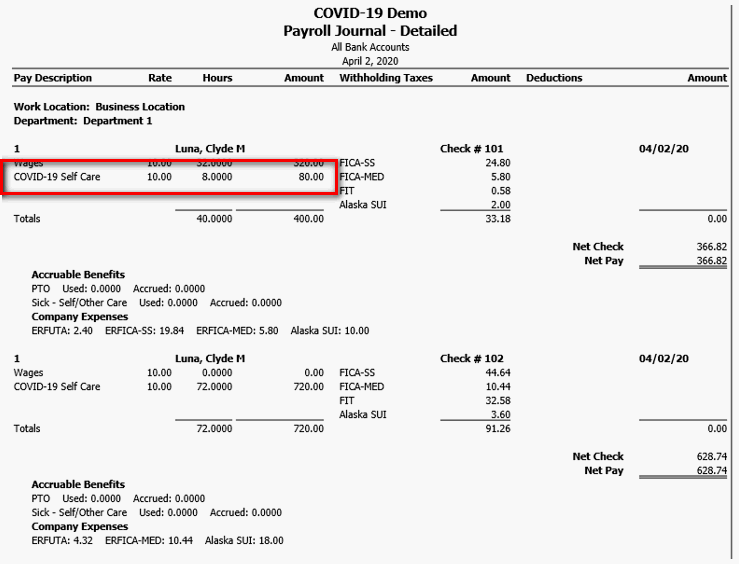
- As a pay item on the company totals page summarizing the total amount used for that payroll. Show me.
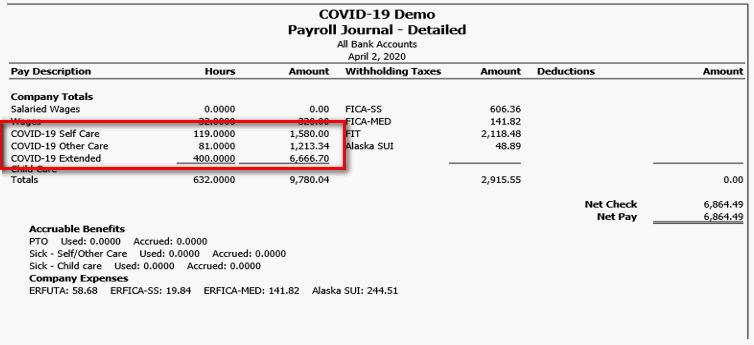
Cash Requirements and Deposits report
There are no changes to the Cash Requirements and Deposits Report as Development is anticipating the variables to be updated soon.
- The tax liability will be reduced by the FICA-SS employer amount.
- If a credit forward is available, it will not reflect here either. Show me.

Depository Totals report
There are no changes to the Depository Totals Report as Development is anticipating the variables to be updated soon.
- The tax liability will be reduced by the FICA-SS employer amount.
- If a credit forward is available, it will not reflect here either. Show me.
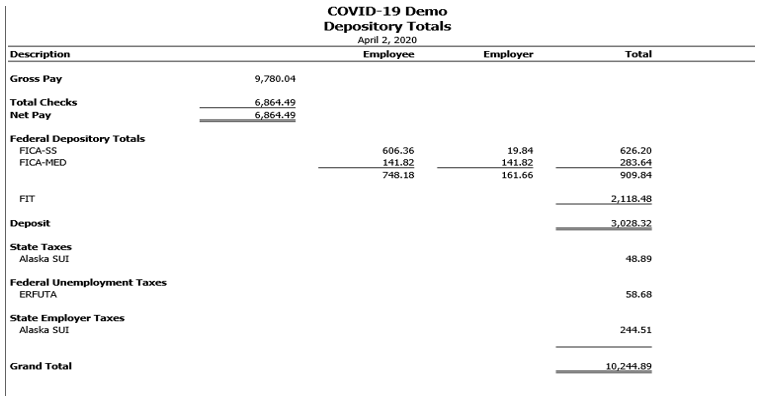
Tax Deposit report
- This report will show the carry over amount the client has available for the next payroll.
- If your client is asking for these Payroll Items to be setup add this report to their report profile to allow them to see the carry over. Show me.

Who qualifies for the expanded leave under FFCRA?
- The Department of Labor has provided guidance and answers to questions about wage limits and who qualifies on their website. Please visit these resources:
- FFCRA Questions and Answers: https://www.dol.gov/agencies/whd/pandemic/ffcra-questions
- FFCRA For the Employer: https://www.dol.gov/agencies/whd/pandemic/ffcra-employer-paid-leave
- FFCRA For the Employee: https://www.dol.gov/agencies/whd/pandemic/ffcra-employee-paid-leave
How can my business take advantage of the payroll tax credits related to FFCRA?
- Employers will be able to claim a payroll tax credit for wages paid for both the Expanded Family and Medical Leave and Emergency Paid Sick Leave.
- A dollar for dollar credit is provided for Coronavirus-related sick leave and paid FMLA wages against the 941 tax liabilities (Employee and Employer paid Social Security and Medicare taxes in addition to Federal Withholding).
- Employers will be able to claim these credits based on qualifying leave they provide between April 1, 2020 and December 31, 2020. Leave benefits and payroll credits will not be retroactive.
- The IRS has released Form 7200 for employers to use to apply for payroll tax credits or anticipated refunds under the FFCRA.
Related articles
Tags
C-19, Coronavirus, ERC
Was this article helpful?
Great! Can you tell us why? (optional)
We're sorry. Can you tell us why? (optional)
Thank you for the feedback!

 myPay Solutions
myPay Solutions
